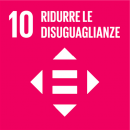Best communication practices in cultural heritage restoration activities: training for young researchers through the analysis of restoration projects – Proff. Olimpia Niglio, Francesca Picchio
- 09, 06, 2022
The course will focus on SDG 4 and SDG 10.
Title: Best communication practices in cultural heritage restoration activities: training for young researchers through the analysis of restoration projects
Provider: University of Pavia, Prof. Olimpia Niglio and Francesca Picchio
Date: 24th November – 19th December 2022
PROGRAM
L1: Introductory Lesson and Overview – 4 hours – Prof. Niglio, 24th November (Zoom link here)
L2: Practical research exercise (two weeks to complete it)- 4 hours – Prof. Picchio, 25th November
L3: Review and classroom work – 4 hours – Prof. Picchio, 15th December
L4: Conclusions and presentation of the works – 4 hours – Prof. Niglio, 19th December (Zoom link here)
Examination: to be defined
Description of the course:
As described in the 2030 Agenda on SDG 4 goal and target, it is imperative to reduce barriers to
skills development and technical and vocational education and training (TVET) and provide lifelong
learning opportunities for young researchers (Target 4.3).
In Cultural Heritage field, technical and scientific skills are increasingly required to promote actions aimed at knowing, protecting, and enhancing historical centers and historical and cultural contexts present on the national and international territory. At the same time, the presence of a professional figure is required who acquires a certain sensitivity to the theme of inclusive design, such as to make the CH accessible in different forms (target 4.4, 2030 Agenda and Heritage and the Sustainable Development Goals: Policy Guidance For Heritage and Development Actors, ICOMOS 2021):
– through the production of CH digital twins, able to replicate in all respects the physical heritage,
often not accessible to all, and, thanks to digital, eliminating those gender-aspect barriers,
accessibility, and access to datas (target 4.3).
– through the implementation of functional CH restoration actions, also implementing appropriate
strategies for inclusive communication, capable of facilitating the reading of those identity and
cultural values that the restoration project intended to promote (target 4.7).
– through the implementation of programs aimed at bringing the younger generations closer to the
local cultural heritage in order to generate inclusive, shared, and participatory actions (Tokyo
Charter, 2021).
The course “Best communication practices in Cultural Heritage restoration activities: training for
young researchers through the analysis of restoration projects” intends to train young researchers
(future architects, engineers, restorers, and designers, specializing in the cultural heritage sector
and in CH education) to approach a restoration project in a transversal way: the goal is to sensitize
them to the aspect of the historical and cultural value of the heritage, adopting communication and use strategies that can be effective and inclusive, for its enhancement and maintenance over time.
In particular, through several lessons, organized with concrete examples of historical heritage
enhancement, carried out both on national and international territory, the course aims to provide the knowledge and technical-operational bases to young researchers, that can be able to critically read a project for the restoration of cultural heritage, evaluate critical issues and possible improvement design solutions from the point of view of communication, use of space, accessibility and social inclusiveness.
At the end of the course, divided into two modules of 8 hours each, the student will be able to propose even simple design solutions, more inclusive and sustainable on cultural heritage, to allow for the maintenance and protection of the restored property over time.
Learning outcomes:
- Basic knowledge of the link between drawings, communication aspects, and restoration activities;
- Ability to analyze a restoration project (criticality of communication strategies and design
potential); - Awareness of sustainable approach and cultural heritage preservation;
- Improving the technical skills in communication strategies;
- Dialoguing with other cultures, appreciating the diversity.
How: in streaming on line
Credits: 2
Time period: first semester 2022
Any prerequisites:Basic notions of drawing, basics of Adobe Photoshop (or other image
processing software), interest in the discipline of cultural heritage restoration and design, interest in education, and social inclusivity issues.
Learning resources: Slides and scientific papers. Exercitation. Every student will be invited to
analyze a specific situation in his own city.
Quality assurance: University of Pavia.


